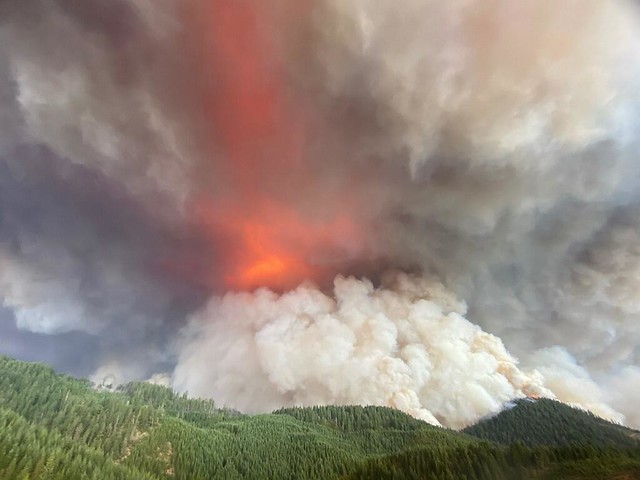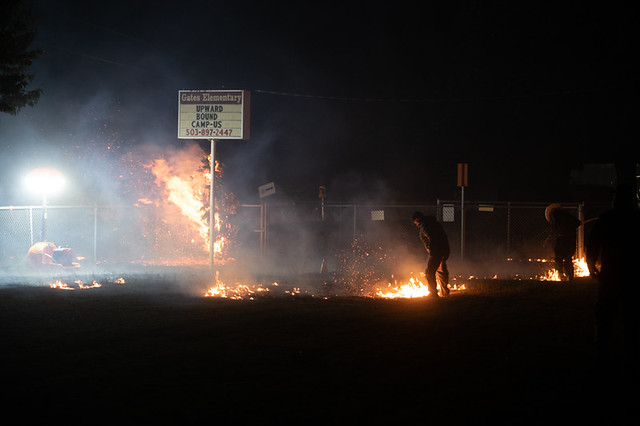
On Sept. 7, 2020, Labor Day, the Pacific Northwest experienced a firestorm of historic proportions. For two days, gusty winds drove dry air from the east, down the west slopes of the Cascade mountains. Wind gusts up to sixty miles per hour collided with record-breaking dry conditions, fanning flames of existing wildfires and creating optimal conditions for new fires to start.
By late September, more than a million acres in Oregon had burned, one of the worst years for wildfires in the state since record-keeping began. More than 800,000 acres burned in neighboring Washington State.
“There is no fire behavior prediction system that we have that even comes close to what we experienced on the ground,” said John Giller, regional interagency director for Fire and Aviation in Washington and Oregon for the U.S. Forest Service and Bureau of Land Management.
Giller said he hadn’t had time to reflect much on what the region had just experienced – his team was still too busy fighting the fires. The region managed as many as twenty large fires between two states in the immediate windstorm aftermath.
“It’s been a very sobering fire season,” Giller said.
Like everyone in the affected area, I have a few stories I could share; the sky that turned black and bruised with smoke, the smog so acrid that it burned to breathe, the tree that cracked in half just outside my front door.

But when I was asked to gather some thoughts for a blog, I hesitated. My stories, however vivid to me, seem so ordinary. Mundane. Maybe they are and maybe they aren’t similar to those of many Forest Service employees in the Pacific Northwest – but by now, even the extraordinary has become strangely ordinary. The stories that stand out for me belong to others.
Mark Turney, public affairs officer for the Umpqua National Forest, was working as a public information officer at the Beachie Creek fire when the incident command post became a fire line. Firefighters in sneakers and flipflops joined those in boots and yellow shirts, beating back the flames. They nearly succeeded, before the wind again whipped up the flames, forcing them to evacuate.

“It was like nothing I’ve ever seen,” the Army veteran said. “It was terrifying. But the professionalism of those guys… I’d go anywhere with them, again.”
Then there’s Joanie Schmidgall, a NEPA planner on the Willamette National Forest who spent the day in a lookout tower outside Detroit, Ore., relaying radio traffic between fire crews, while officials evacuated the Mt. Jefferson Wilderness ahead of the storm.
Spending a night buffeted by near-hurricane force winds, it was the smoke that finally drove her away. She decided to move to a nearby ranger station instead, alongside fifty others taking shelter from the wind.
“It felt like the safest place in the world,” she said. But when she woke up, there was fire outside.
On their escape through Santiam Canyon, trees glowed red from roots to crown on either side of the highway, while fire appeared to ripple across the forest floor like lava. Fallen trees and limbs were everywhere.
Firefighters camped on the other side of the canyon, in Gates, Ore., had raced into the burning pass from the other side to clear the way, she later learned.

Nearby, Forest Service firefighters led 70 residents from Detroit Lake to safety, threading the needle over forest roads through Mt. Hood National Forest when Highway 22 was blocked by converging fires on both sides.
Their Incident Commander, Noel Livingston, demurred every time I asked for their names.
“They don’t want to be stood up as heroes. They were just firefighters, doing their jobs,” he said.
Wildland firefighter and Forest Service culture strongly discourage taking any unnecessary risks. That’s important because these jobs are inherently dangerous, and hazards are everywhere.
This wildfire season has taken a heavy toll. Two pilots have died fighting fires in Oregon, and several firefighters have been injured.
“There are many heroes. So many stories that haven’t been told yet, by people who may never be interviewed,” Giller said. “This has been a sobering fire year.”
It’s also been a longer season than usual. Interagency staff worked long hours starting in March to design protective measures to minimize the spread of COVID-19 among firefighters, who traditionally work and live in close quarters throughout the fire season.
Throughout the summer, firefighters and support staff deployed in force as part of an aggressive initial attack strategy aiming to keep resources and staffing from being maxed out. Eventually, though, warm weather, lack of rainfall and low relative humidity began to take their toll.
By September, the strain was starting to show, Giller said. Some seasonal firefighters declined offers to extend their tours of duty, and exhaustion had set in among firefighters and support staff.

But when the wind came, and fire followed, a community came together to face the crisis.
It’s hard to overstate the impact this disaster has had, particularly on some of our forest communities. By now, you’ve probably seen the headlines, and the photos.
Damage is still being assessed, but the numbers we do have paint a grim picture. Yet when I brush away the debris, it’s a picture of hope that emerges.
“It’s really incredible, how our community just came together,” said Kathy Westenskow Davis, deputy forest supervisor on the Rogue River-Siskiyou National Forest. She said she was awed by how her employees immediately opened their homes to others, while local and national organizations had mobilized to meet evacuee needs.
She told me all this at the end of her workday, which she’d split between office work and her insurance claim. Her and three other forest employees were among the 2,350 residential structures state officials estimate burned in the Alameda fire.
“I’m taking it day by day,” Davis said. “I’m living in a motel with my husband, and two dogs; one of them is a two and-a-half-month-old puppy… but we’re together.”
Whether their uniforms are Forest Service green or firefighter yellow, colleagues all around me have risked their lives opened homes and opened hearts to those in need.
I’m surrounded by heroes.
As teams begin to assess the damage, I expect they will find both devastation and reasons for hope among the ashes. And as the Forest Service’s Operation Care and Recovery team begins to assess employee needs created by wildfires and other disasters, including the pandemic, I think they’ll find the same optimism.
In some ways, lives will be forever changed by these events and experiences; both individually and collectively. In other ways, the pandemic and these wildfires have made it clear this is always who we were... and that This is Who We Are (PDF, 3.8 MB).
“I’m honored and humbled to be able to lead such a dedicated and selfless workforce. They did amazing things in the face of danger, and undoubtedly saved lives, saved homes. I’m just really proud to be associated with them,” Giller said.
I see that resilience in our communities, too. Friends and neighbors rally to gather supplies for others. People go online to express thanks and gratitude. A child donates a stuffed toy to firefighters in Oregon, and it becomes a national social media phenomenon.
Heroism takes many forms. We are facing the extraordinary. But you are also extraordinary.
I don’t know how this chapter in our story ends yet, but I’ll conclude by saying: to all my heroes, named or unnamed, whether doing the hard work or the “heart work” -- thank you.



